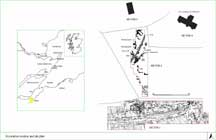 Bulletin 7, 2001-2
Bulletin 7, 2001-2
Summary
The Tarbat Discovery Programme began in 1994 with an evaluation of the site of St Colman’s Church, Portmahomack, and its ditched enclosure, discovered from the air in 1984. This evaluation (1994-1995) which formed Stage 1 of the campaign, was supported mainly by Highland Council (Bull. 1). It led to a Project Design aimed at the understanding of a suspected Pictish monastery and its context. In this design, we planned a major excavation inside and outside the church of St Colman at Portmahomack and an intensive survey of the Tarbat peninsula (Bull. 2).
The Project Design was approved in 1995 and formed part of a collaborative venture with Tarbat Historic Trust and Highland Council which was funded largely by the Heritage Lottery Fund. The archaeological component consisted of the excavation of four sectors amounting in all to about 0.8ha.. Sector 1 formed the east-west area over the south part of the enclosure and Sector 2 the north-south area running from sector 1 to the churchyard. Sector 3 was a small property on the north side of the church, and Sector 4 the church itself (see location map). All sectors were stripped and mapped before excavation began.

Click to view larger image of the location map (188k).
The first large excavation area to be completed was Sector 4, St Colman’s church, where a sequence of 5 earlier churches (8-19th century), 165 burials (6-16th century) and 10 pieces of sculpture (6-8th century) were brought to light in 1997 (Bull. 3). Sector 3 was excavated in 1996 and showed a small number of mainly undated features cut into sand dunes (Bull. 2). The excavation of Sector 1 began in 1996 and is scheduled for completion in 2003. Exposed beneath shallow topsoil (c.300mm) were the series of consecutive enclosure ditches, a feature possibly associated with corn drying and some debris deriving from non-ferrous metal-working. The excavation of Sector 2 also began in 1996 and has proved to be a deposit of exceptional depth and complexity. By 2002, excavations had exposed a road with work-shop areas on either side leading to a millpond and dam. (See Bull. 4, Bull. 5 and Bull. 6).
The excavation programme 1996-2000 (with concomitant post-excavation) as approved and funded by the Heritage Lottery Fund is here termed Stage 2 of the campaign. It was intended that these five seasons would be sufficient to complete the whole excavation programme; but this was not achieved due to the complexity of the workshop area in Sector 2, where the depth of the deposits, the richness of the assemblage and the extraordinary opportunity to understand an early monastery demanded extreme care.
From 2001, the campaign has followed a final stage of fieldwork (Stage 3) sponsored principally by Tarbat Historic Trust, the National Museums of Scotland and Historic Scotland. In this phase, the aim is to complete the original design and see it published. The excavation is proceeding by a number of studies of particular structures, activity areas or problems, in the hands of a small professional team. In 2001 and 2002, these studies were mainly directed at the enclosure ditch and the structures in Sector 2. The results from these two seasons are reported in this Bulletin (Excavations at Portmahomack 2001-2).
The post-excavation programme continues, aimed at the preparation of two projected volumes of publication (see Research in progress). The discoveries at Tarbat are being discussed in a range of interim publications and public lectures in Scotland, the continent and USA (see Publications). Plans for the future completion of the excavation, investigations on the Tarbat peninsula, for the supporting research, publication, and the conservation and presentation of the site are periodically refreshed. The latest plans are given in Programme Update.
Martin Carver
York, 11 Jun 03
NEXT: Excavations
BACK: Credits
Last updated 10 October, 2003.
Contact the Tarbat Discovery Programme


